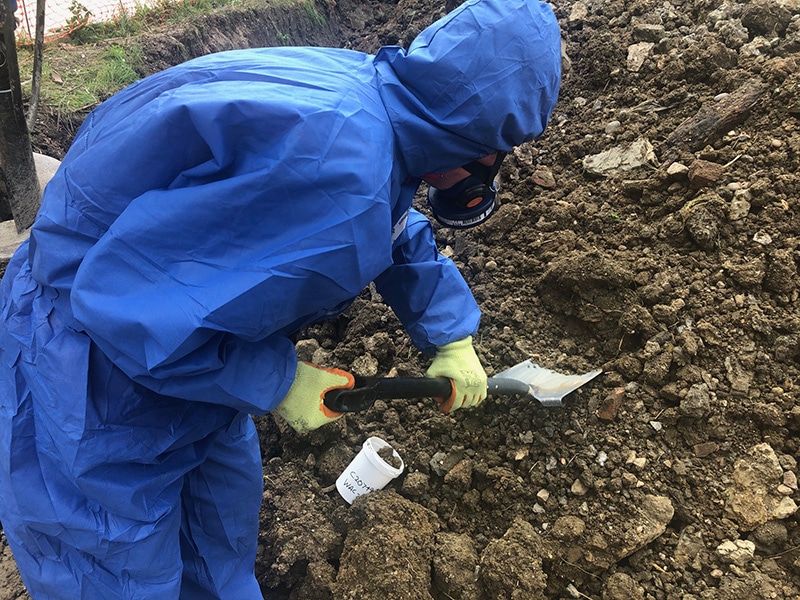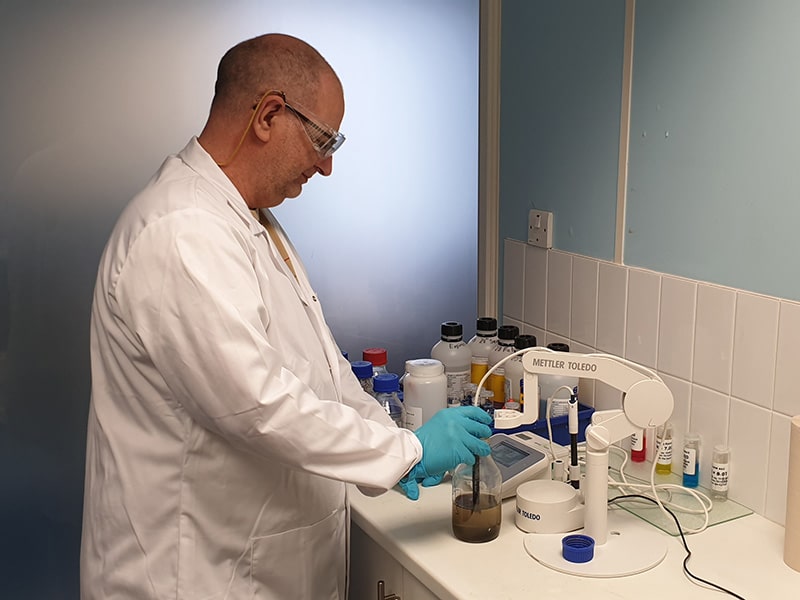What is WAC Testing?
Waste Acceptance Criteria (WAC) decides the safest place to dispose of certain types of waste. WAC began as part of the UK government’s effort to lower the dependency on landfills while minimising the impact landfills make on both the environment and people’s health. As a result of efforts like these, stricter regulations have emerged, such as the requirement that waste is now categorised and meets WAC standards before it goes into a landfill.
When you’re managing land with possible asbestos contamination or the presence of other hazardous materials, there are legal requirements to follow. According to the UK government website, the following must take place before waste is disposed of in a landfill:
- The waste must be classified as either hazardous or non-hazardous.
- The waste must be treated.
- It must be determined if the landfill can accept the type of waste being disposed of.
An example of treating the waste is making it flammable instead of highly flammable or removing some substances that can be polluting.
For our purposes, the definition of waste, according to the Waste Framework Directive (2009/98/EC), is “any substance or object which the holder discards or intends or is required to discard.”
What is WAC testing?
WAC testing determines:
- If soil (or another organic material) can go into a landfill for disposal.
- What type of landfill is appropriate for depositing the waste.
- How the waste will act over time once it’s buried in the landfill.
The type of material and how it’s predicted to act over time determines where that material can be put.
While WAC testing is used when soil is contaminated with asbestos, it also tests for other types of contaminants. For example, testing for chemical pollutants, hydrocarbons, and metals typically takes place. In general, anything that could be hazardous is tested for with WAC.
How is WAC testing carried out?
Testing offers an overview of any possible issues that may arise from putting the waste in a landfill. WAC testing has two basic parts. The first is analysing the solids. The second step is analysing the leachates (the liquid that drains from the organic material when it’s buried) in the organic material.
- Solid analysis: This part of the test finds out how much of the material is organic and which contaminants are present.
- Leachate analysis: This part of the test is to find out how much of the contaminant will leach out once the material is in a landfill.
Note that since WAC testing isn’t used to tell if waste is hazardous or non-hazardous, the Waste Classification Test occurs first.
When do you need a WAC test?
You’ll need WAC testing services if the project you’re in charge of requires the management of asbestos-contaminated land.
WAC testing takes place after a waste classification test is carried out on the soil. This is to determine if the waste is hazardous or non-hazardous. You can learn more about how the Environment Agency classifies different types of waste here.
Why is WAC testing important?
There are many different kinds of landfills in the UK. Without the proper testing, the materials that go into the landfill can cause problems to the environment as well as human health and safety.
For example, leachates may impact ground or surface water. An inert landfill that ends up with hazardous waste in it could expose people to leachates that are toxic.
Certain types of landfills can handle certain types of waste. WAC testing ensures that material disposal happens at the correct type of landfill, meaning one that’s equipped to handle it.
What are the different types of WAC tests?
There are two main types of WAC tests: the inert test and the hazardous test. Stable non-reactive hazardous waste is also a consideration. Here’s an overview of each one:
The inert WAC test
The safest type of waste is inert waste. This waste produces low leachate levels. It can be disposed of in a basic (or “inert”) landfill.
However, sometimes non-hazardous waste will still fail an inert WAC test, which means it can’t go into an inert landfill. Instead, it will go into a non-hazardous landfill.
The hazardous WAC test
If the Waste Classification Test determines that the organic material is hazardous, the hazardous WAC test will take place. If the waste passes the WAC test, it can go into a hazardous landfill. If it doesn’t pass the test, more treatment will occur before it goes into a landfill.
What is a stable non-reactive hazardous landfill?
This type of landfill is made up of cells, and it’s a less-common landfill type than an inert or hazardous landfill. A stable non-reactive hazardous landfill allows for chemically non-hazardous material that has a hazardous amount of asbestos.
WAC testing is not required if the soil is going to be disposed of in this type of landfill. It’s only required if the material may be disposed of in an inert or hazardous landfill.
What is the Asbestos in Soils Test?
The Asbestos in Soils Test determines if asbestos is present in the soil and how much exists. There are three basic stages to this test:
- Screening the soil to identify the asbestos.
- Gravimetric analysis, which finds out the percentage of asbestos present.
- Fibre counting if the percentage of asbestos present is under 0.1 percent or if the sample has loose asbestos fibres.
If there’s more than 0.1% of asbestos in the soil, the material is automatically considered hazardous. Also, if there is any asbestos-containing material in the soil, such as a piece of cement, it will be automatically considered hazardous waste.
Note that the Asbestos in Soils Test is not the same as a WAC test, though it may be carried out along with WAC testing.
Who is responsible for WAC testing?
The waste producer has a duty of care, which means they’re responsible for making sure that the waste is properly categorised. The penalties for a waste offence range from warnings to prosecution and monetary payments.
Sometimes, a contractor or waste treatment professional will come to your place of business to remove the waste and bring it to a landfill. In this case, it’s the waste producer’s responsibility to give them the information they need to decide where the waste can go.
Similarly, if you’re disposing of the waste yourself, you need to follow the proper guidelines for disposing of it correctly.
The landfill operator also plays a role. They must agree that a basic waste categorisation is complete before they can accept the waste.
What if the landfill doesn’t require waste classification?
There may be some confusion over what’s required by law when the landfill itself doesn’t require classification. There are some landfills that don’t have this requirement. However, that doesn’t change the legal need for waste classification. Despite the landfill’s rules, the producer of the waste still has a responsibility to correctly classify the material before disposal.
Is WAC testing mandatory?
WAC testing has been mandatory since 2005. That’s when the Landfill Regulations came out, which has specific guidance about sampling and testing. Testing shows if the waste meets the requirements for a hazardous landfill or where it can be put otherwise.
What should soil be tested for?
Before WAC testing can occur, the soil needs to be tested to determine if it’s hazardous or non-hazardous.
Soil testing looks for any and all contaminants that you think may be present. It’s helpful to have the history of the site to make this determination. For example, it’s useful to refer to maps and data from previous site investigations.
At the least, testing should cover common contaminants like asbestos, hydrocarbons, and metals. Testing for other contaminants is a good idea if you’ve acquired information about the site and have other concerns.
Can hazardous waste be made non-hazardous?
Sometimes, it’s possible to reduce hazardous waste to a non-hazardous status. One way to do this is by separating hazardous material from nearby non-hazardous material. This can limit the amount of soil that’s readied for disposal at a hazardous landfill.
Another option depends on the amount of contaminants in the waste. Sometimes, the material can be treated so that contaminants are reduced and the waste becomes non-hazardous.
What is involved in carrying out WAC testing?
There’s a preliminary step that must take place before WAC testing: the Waste Classification Test.
What is the Waste Classification Test?
WAC testing can’t take place until it’s determined if the organic material is hazardous or non-hazardous. This happens during a Waste Classification Test. The waste’s classification then determines which type of WAC test is needed.
What happens during WAC testing?
Whether waste classification is hazardous or non-hazardous, WAC testing takes place after the Waste Classification Test. WAC testing looks at both the solids and the leachates of the material to determine which type of landfill is appropriate for its disposal.
Commonly, WAC testing occurs immediately after soil testing so as not to delay the disposal process.
Contact us today if you’re concerned about asbestos contamination in land and soil.

Written by Mark Carter
Mark Carter is a renowned expert in asbestos management, offering clients vital guidance on compliance and safety. His expertise is invaluable for navigating asbestos regulations, ensuring both safety and legal adherence. Mark's role is central in providing effective asbestos-related solutions, helping clients achieve their business objectives with an emphasis on regulatory compliance and safety in asbestos management.


